Crafting Your Mission Statement: Best Examples & Ready-to-Use Free Templates
Every business wants to put their best foot forward, and the key to this is a strong mission statement. It reflects the very essence of who you are, what you do, and why you do it. But how do you create a mission statement that resonates with everyone involved and accurately represents your company?
This article is here to provide you with an insightful look into how to craft an effective mission statement. Dive in to find the best mission statement examples and free customizable mission statement templates.
What is a mission statement?
A mission statement is a concise declaration that outlines a company’s core purpose, objectives, and direction. It provides customers and employees with a clear understanding of why a company exists and what it hopes to achieve in the future.
Typically, a mission statement will encapsulate the following key elements:
- Core values: what principles guide the company’s decision-making?
- Target audience: who is the company aiming to serve or support?
- Products: what does the company offer to fulfill its purpose?
- Commitment to stakeholders: how does the company seek to impact its community, environment, or other key stakeholders?
Mission statements vs. vision statement vs. values and goals
Mission statements often get confused with other aspects of a brand’s identity, so let’s clear things up:
Mission statement: defines the present purpose.
A mission statement defines a company’s reason for existence, outlining its current objectives, core products, and commitments. It answers the question of “Why do we exist?” and focuses on the present.
Vision statement: envisions the future state.
A vision statement provides a long-term perspective and paints a picture of a company’s future. Unlike the mission, it is aspirational, capturing what the company’s hopes are. It answers the question of “Where do we want to go?” and focuses on the future.
Core values: represent the ethical principles.
Core values are the guiding principles and ethical benchmarks that cover every aspect of a company’s operation. They define the company’s culture, guide decision-making, and influence interactions with stakeholders.
Goals: sets specific targets.
Goals are specific, measurable, attainable, relevant, and time-bound objectives that a company seeks to accomplish. They are concrete targets that align with mission, vision, and values, offering a clear roadmap for success.

5 best mission statements of all time
1. Google mission statement
“To organize the world’s information and make it universally accessible and useful.”
Insight: This statement reflects Google’s core commitments that guide all their products and services.
2. Disney mission statement
“To entertain, inform and inspire people around the globe through the power of unparalleled storytelling.”
Insight: Disney focuses on an emotional connection, showcasing their dedication to storytelling and creativity.
3. Microsoft mission statement
“To empower every person and every organization on the planet to achieve more.”
Insight: Microsoft’s mission connects technology with empowerment, showing aspiration to enhance individual and organizational capabilities.
4. Nike mission statement
“To bring inspiration and innovation to every athlete* in the world. (*If you have a body, you are an athlete.)”
Insight: Nike’s inclusive approach transcends professional sports, inspiring every person to recognize their potential.
5. Starbucks mission statement
“To inspire and nurture the human spirit – one person, one cup and one neighborhood at a time.”
Insight: Starbucks aims to create a community and personal connection, not just sell coffee.
Why is a mission statement important?
A mission statement is more than just a slogan; it’s a critical tool for defining and conveying the core purpose of your company that resonates through every aspect of its operation.
Here are several reasons why it’s important for a company:
- It guides every decision and action within the company, ensuring alignment with its main purpose.
- It helps foster a unified culture by providing a common understanding of why the company exists and what it seeks to accomplish.
- It provides a foundation for strategy development, ensuring that long-term goals and short-term objectives are in line with the company’s core purpose.
- It inspires and motivates employees by connecting their daily work to a higher purpose, leading to increased job satisfaction and performance.
- It serves as a clear message to all stakeholders about what the company stands for and what it aims to achieve.

How long should a mission statement be?
A mission statement should be as brief as possible, while still clearly conveying a company’s main purpose, values, and ambitions. Ideally, it should be one to two sentences long, but it can stretch to a brief paragraph if necessary.
For example, Tesla’s mission statement: “To accelerate the advent of sustainable transport by bringing compelling mass-market electric cars to market as soon as possible,” conveys the company’s focus on sustainability and innovation. On the other hand, the Walt Disney Company’s mission is “To entertain, inform and inspire people around the globe through the power of unparalleled storytelling,” which illustrates how a short mission statement can embody a company’s creative vision.
What makes a good mission statement?
- Clarity. A mission statement should be easy to understand. Overly complex or verbose statements can confuse readers.
- Conciseness. A mission statement should be concise enough to be easily remembered but long enough to cover key aspects. If it’s too long, the core message might get lost.
- Comprehensiveness. While conciseness is essential, a mission statement must also be comprehensive. It should cover main points, such as purpose, target audience, and core values.
- Alignment with brand voice. The length and tone should align with a brand’s overall voice and communication style.
- Flexibility for different uses. A concise mission statement should be versatile to be used across different platforms.
What are mission statement mistakes to avoid?
1. Using jargon or complex language.
Your mission statement needs to resonate with a wide audience, including employees, customers, partners, investors, and most importantly the general public. Falling into the trap of using industry-specific jargon or overly complex language can create barriers to understanding.
- Use plain language. Write your mission statement in a straightforward and clear language that anyone can understand, regardless of their familiarity with your industry.
- Test it out. Share the statement with individuals outside your industry and ask for their feedback. If they can’t easily grasp the meaning, consider rewriting.
2. Focusing only on making profit.
While making a profit is crucial to most businesses, a mission statement that focuses solely on this aspect can come across as superficial or short-sighted. The statement should go beyond just making money, speaking to the higher purpose or impact your company seeks to have.
- Identify your why. Look beyond profit to identify the core purpose that drives your company. Is it innovation, community connection, sustainability, or something else? Make this a central theme in your mission statement.
- Balance profit with purpose. It’s okay to mention profitability or growth, but balance this with how your company seeks to impact the world or industry positively.
3. Not involving your team.
Your mission statement should resonate with everyone in your company. It’s not a top-down directive, but a collective expression of your company’s purpose. By not involving your team, you risk creating a mission that doesn’t resonate or align with the very people responsible for carrying it out.
- Ask for input. Encourage team members to share their thoughts on the company’s purpose, values, and goals. This can be done through surveys, workshops, or one-on-one discussions.
- Build together. Consider collaborative sessions where your team can work together to craft or refine the mission statement. This can foster collective ownership and investment in the mission.
4. Being unrealistic.
Ambition is essential, but if your mission statement sets goals that are clearly unattainable, it can lead to frustration and demotivation within the team. If they feel the goals are impossible to achieve, they may not fully commit to trying. It can also harm your company’s credibility and trustworthiness.
- Align with reality. Ensure that the mission aligns with what is realistically achievable. This doesn’t mean avoiding ambition, but rather making your goals actually attainable.
- Regularly review. Continuously evaluate and revise the mission statement to ensure that it remains relevant and attainable as the company evolves. This keeps it alive and meaningful within the company.

How to write a mission statement
1. Understand your purpose.
Your mission statement should articulate why your company exists and what it hopes to achieve. Understanding this purpose is the cornerstone of a meaningful mission statement.
How to do it:
- Assess your goals. What are the long-term goals of the company? What unique value do you provide to your customers, community, or industry?
- Consider your impact. Look beyond financial goals to consider the broader impact you seek to have. Is it about innovation, customer service, social responsibility, or something else?
- Talk to stakeholders. Engage with employees, customers, and other stakeholders to understand what they see as the essential purpose of the company.
2. Identify core values.
Core values are the principles that guide your company’s behavior and decision-making. These values should be reflected in your mission statement to ensure coherence.
How to do it:
- List your values. Start by identifying the principles that define your company’s culture and guide its decisions. This might include integrity, innovation, collaboration, customer focus, etc.
- Ensure alignment. Cross-reference the values with the identified purpose to ensure they align. The values should support the purpose, not contradict it.
- Involve your team. Engage with team members to ensure that the values are not just aspirational, but reflective of the real culture within the company. They should resonate with those who live them daily.
3. Outline your strategy.
The strategy outlines the methods your company will employ to fulfill its mission. It’s a concise roadmap that guides the actions necessary to achieve the purpose.
How to do it:
- Define key actions. What are the main actions or approaches your company will take to fulfill its mission? This might include partnerships, technological innovation, or community engagement.
- Keep it simple. The strategy in a mission statement is an overview, not a detailed plan. Make it concise and focused on key strategic points.
4. Analyze your audience.
Understanding who will read and interact with the mission statement is crucial. Different stakeholders may perceive it differently, so it’s important to craft a statement that resonates with a wide range of people.
How to do it:
- Identify key stakeholders. Who are the main audiences for the mission statement? This likely includes employees, customers, investors, partners, and the general public.
- Consider their perspectives. What do these different groups value and expect from your company? How can the mission statement resonate with their interests and needs?
- Test the statement. If possible, share drafts of the mission statement with representatives from different stakeholder groups and ask for feedback.

5. Be clear and concise.
A mission statement should be easily understandable. Overly complex or verbose statements can confuse readers.
How to do it:
- Use plain language. Avoid jargon or overly complicated words. Speak plainly so that anyone, regardless of their familiarity with your industry, can understand.
- Avoid clichés. Generic or buzzword-filled statements can feel insincere. Strive to keep it brief and use authentic language that truly reflects your company’s character.
6. Make it inspiring and authentic.
An effective mission statement should motivate and inspire those who read it, while also genuinely reflecting what your company stands for.
How to do it:
- Speak to the heart. Think about what makes your company unique. How do you uplift your customers, employees, or community? Make sure this comes through in your statement.
- Align with reality. Ensure that the mission statement is not just aspirational, but also an authentic reflection of your company’s daily reality.
7. Align with your brand.
Your mission statement must be consistent with your brand’s overall messaging, tone, and positioning. A misaligned mission statement can create confusion or undermine trust in your brand.
How to do it:
- Review brand guidelines. Compare the mission statement with your overall brand guidelines to ensure consistency in tone, language, and messaging.
- Integrate with other brand content. The mission statement should not stand alone. It should be integrated with other brand content and the overall narrative.
8. Write and revise.
This step is all about putting pen to paper and refining the draft into a polished final version. Be prepared to revise it multiple times to make the message engaging.
How to do it:
- Draft multiple versions. Write a few different versions to explore the best way to convey the ideas you’ve outlined.
- Seek feedback. Share the drafts with stakeholders who have been involved in the process to gather feedback.
- Revise thoughtfully. Take the time to revise and refine the statement. Pay attention to word choice, rhythm, and overall readability.
9. Test and Implement.
Once you’ve crafted a strong mission statement, it’s time to see how it resonates and make it a living part of your company. Use feedback to make final adjustments and incorporate the mission statement into all aspects of your company.
How to do it:
- Test with a broader audience. Share the final draft with a wide audience, if appropriate, to understand how it resonates. This could include loyal customers or even focus groups.
- Spread it. Make the mission statement visible and an integral part of your business. It could appear on your website, marketing materials, or even office walls.
- Reinforce regularly. Ensure that the mission statement is not just a slogan. It should be regularly referenced and reinforced in meetings, as well as training, and decision-making processes.
Best mission statement examples
1. Patagonia.
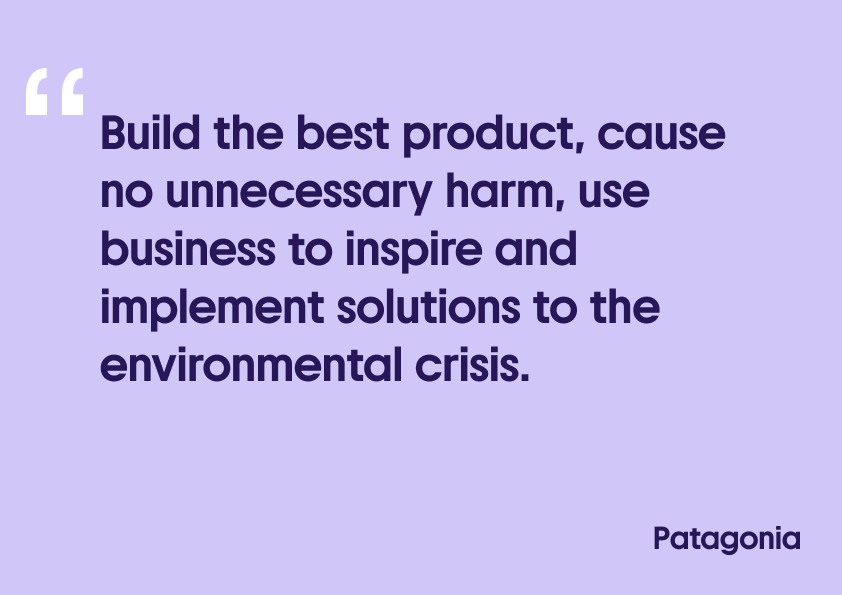
2. McDonald’s.
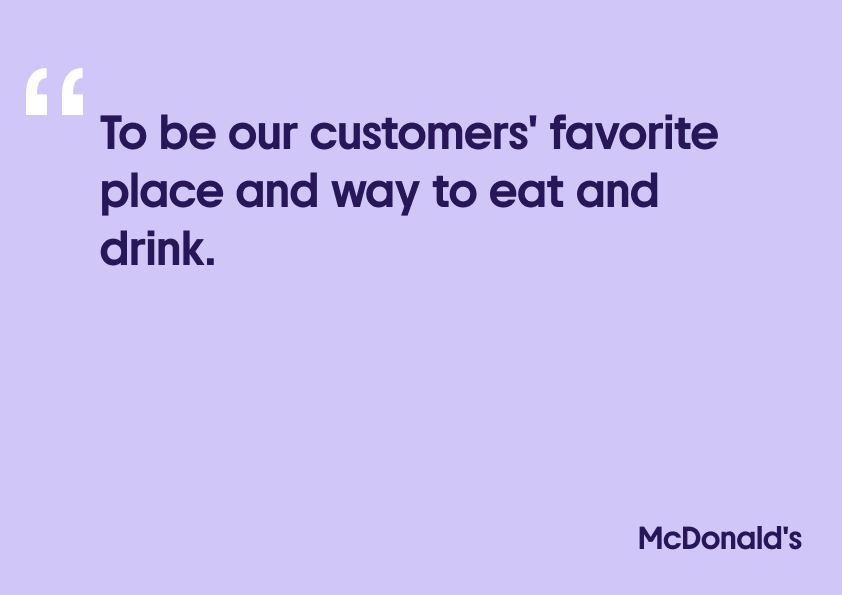
3. Lululemon.
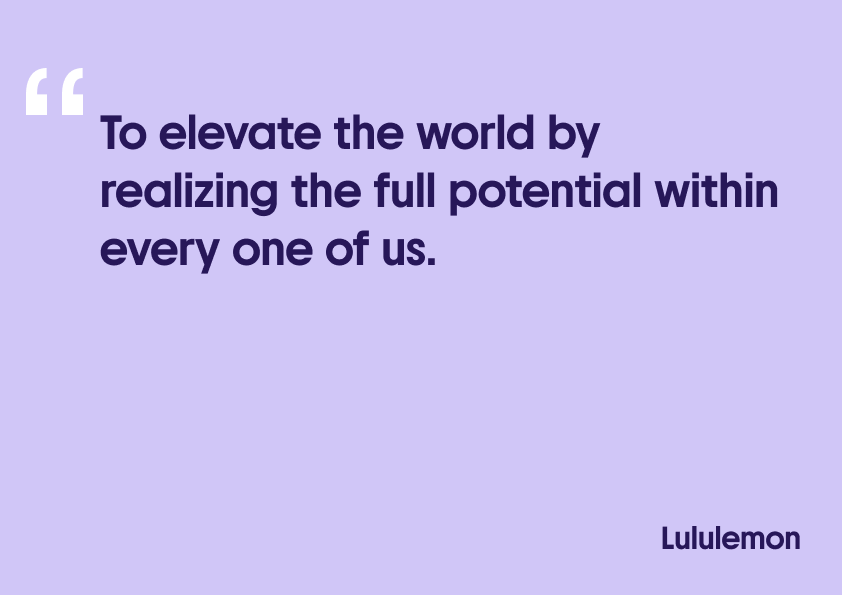
4. Adidas.

5. Uber.
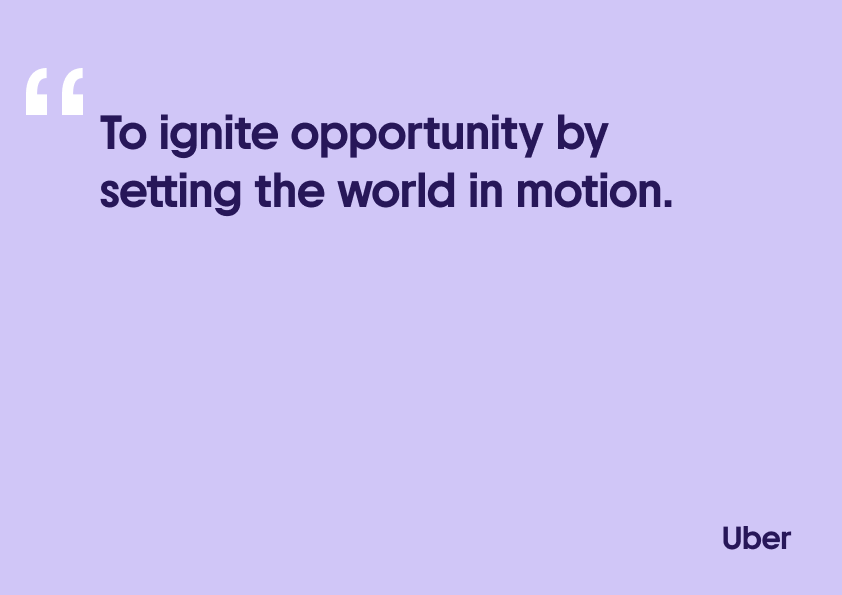
6. Spotify.

7. Deloitte.

8. Airbnb.

9. Meta.

10. IKEA

11. Under Armour.

12. LinkedIn.
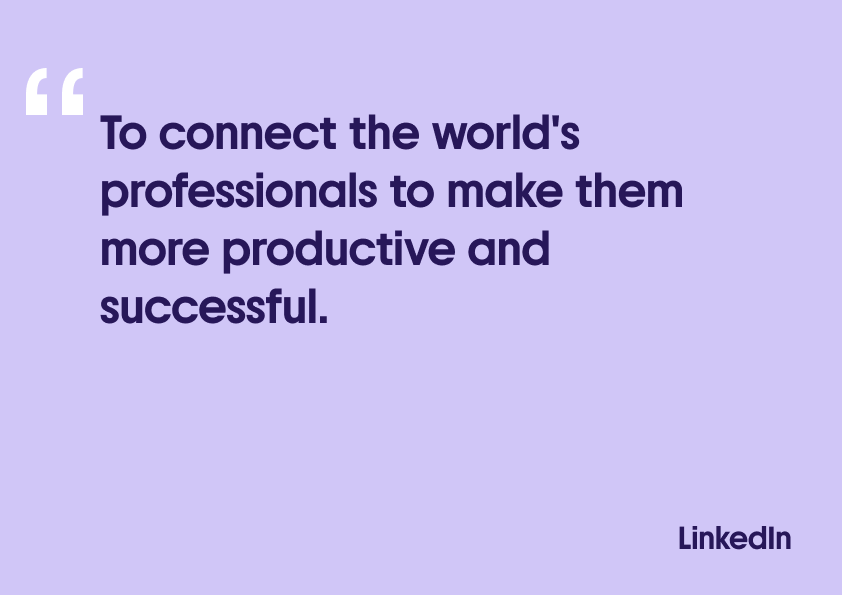
13. Pepsi.

14. Netflix.

15. Walmart.

Use these mission statement templates to create your own
1. For product-focused missions.
“To deliver [product] that empowers our customers to [specific benefit], through innovation, quality, and commitment.”
2. For service-oriented missions.
“Our mission is to provide [target audience] with incomparable service, focusing on [key aspect], to enhance/improve [desired outcome].”
3. For social or environmental missions.
“We are dedicated to [social or environmental goal] by [key actions], inspiring change and making a lasting impact on [target community].”
4. For technology-focused missions.
“To revolutionize [industry] by creating cutting-edge technology that enables [specific benefit], connecting people and ideas.”
5. For creative-oriented business.
“We make [specific type of creative work] to inspire people. We want to bring joy and [positive feeling or value] to [target audience].”
6. For retail-focused businesses.
“To enrich our customers’ lives by offering [product] that combines quality, value, and style in an environment that excites and inspires.”
To wrap up
An effective mission statement is not merely words on a page. It’s a living concept that influences every part of your company, helping you align actions and decisions with your company’s identity. It can also serve as a powerful marketing tool, helping attract customers who share the company’s values. Crafting a mission statement can be a daunting task, but by following this article, it becomes an easily manageable process.
Other articles you might find interesting
40 Types of Marketing You Can Use in 2023
Creating a Marketing Plan: Steps, Types & Expert Tips
Leadership Styles Demystified: Finding Your Path to Success
10 Best Data Visualization Tools and Techniques in 2023









